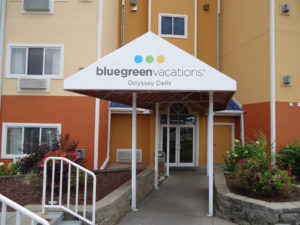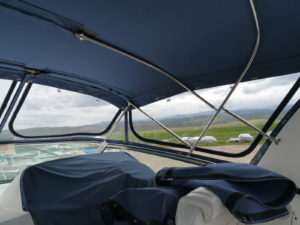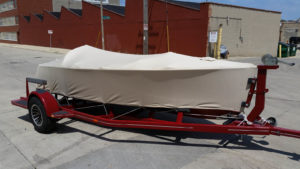Estimating for profit

Marine fabricators are accustomed to the occasional request for work on the side. It’s important to take the time to think of everything that could present a challenge, notes Kathy Schaefer of Glawe Awnings and Tents in Fairborn, Ohio.
Understanding the customer’s unique wants and requirements goes to the heart of successful custom projects.
Larry Schneider of Homestyle Upholstery and Awning in Bayview, Wis., recently worked on a project that seemed like it would be fairly simple, and one marine fabricators might recognize—adding screens to a car trailer so the customer could sleep in it. After discussing it with the customer, he wasn’t looking for anything simple.
“All of a sudden he wanted a door, then a magnetic door with a zipper. As we talked, it kept progressing, and we were working out the design,” he says. “It always starts out, ‘Oh, this should be simple; it won’t take you any time at all.’ Then it’s ‘How am I going to make it do this trick?’”
Estimating custom jobs gets complicated because each is unique. A long-term fabricator, Schneider relies on his knowledge and past experiences. What he has come to understand is how to get to the heart of the customer’s needs, wants and expectations. “It always starts with the customer,” he says. “If they don’t know what they want, at least find out what they need, what they want the product or the service to do for them. Then you can give them some options.”

“We’re selling custom creations, and getting every job spot-on in an estimate is just not realistic,” notes marine fabricator Carl Pelligrini of SeaCanvas. “We at times will spend more time than estimated on a job, but the final product will shine, the client will be thrilled and another lesson should be learned from the experience.”
Take the time to do it right
Accurate job-costing takes time for a profit to be realized. For this reason, Dawn Taylor, MFC, from Marine Canvas Training Institute in Palmetto, Fla., teaches apprentices to always make a checklist of everything that needs to go into the job and never give an estimate over the phone, even if it is something they’ve done before.
“We always go look at the [customer’s] job first because a lot of times, what they’re telling us is not everything,” Taylor says. “Sometimes we have to check how we can get access to the boat. For instance, if it’s on a boat lift on the water, we can’t walk on water. It may have to be put on a float. Often they don’t tell us if it’s an open boat or a T-top.”
Taylor says she tries not to have unexpected issues come up, but when they do, she has to work around them. “Because we’ve gone to look at the boat, we don’t change our estimate unless the customer makes the change. If we made a mistake and had to put in more time, that’s
our problem.”
Many marine fabricators take on commercial projects, too, and it’s important to take the time to think of everything that could present a challenge, says Kathy Schaefer, chief operating officer at Glawe Awnings and Tents in Fairborn, Ohio. The company does a site survey and photographs the surrounding area when meeting the customer.
Labor costs are complex
While material costs can be predictable, labor costs can be a tricky proposition. Lessons learned from the past help address some of these issues, says Carl Pelligrini, owner of SeaCanvas LLC in Egg Harbor Township, N.J. An upholstery interior, for example, may require the need to break down some interior parts, such as wood trim or hardware, to get into the area to be finished. Approximate time needs to be assessed with a reasonable open end for these types of issues.
“Discussing and including this time adjustment with the customer needs to happen and [be] included in a contract or estimate. Most exterior work, such as bending new framework and creating an enclosure is straightforward. The worst we would run into there is setting new fittings in the fiberglass that needs work.”

No two jobs are exactly alike, nor do all customers want everything the same. Projects like this custom boat cover have more to do with craftsmanship and sewing than technology. Longterm experience gives fabricators the confidence to estimate jobs accurately. Photo: Homestyle Awning & Upholstery
Look at it as a learning lesson if the hours add up to more than your quote, Pelligrini adds. “We’re selling custom creations, and getting every job spot-on in an estimate is just not realistic. We at times will spend more time than estimated on a job, but the final product will shine, the client will be thrilled and another lesson should be learned from the experience.”
Labor costs need to take into account where the jobsite is and how many people are needed at the site, says Andy Moon, chief executive officer at Baraboo Tent and Awning in Baraboo, Wis. Things like hotels and travel costs for overnight stays and per diem costs must be included in estimating a project.
“The location of the job is key,” he says. “How close can we park our truck to the actual site? How high in the air are we going? Safety adds dollars. Do we need to rent a lift, have extension ladders or cranes?” Moon says his company is always looking for new equipment that can help lower labor costs.
Purchasing equipment has helped Schaefer with profitability of certain jobs. She will order equipment to assist with an install rather than send more installers or spend more time moving ladders. “I found that I was renting a scissor lift so often, I ultimately purchased a used one from our rental company. Using our lift on higher jobs not only saves time, but also is much safer than using a ladder and balancing an awning.”
Estimates must also reflect higher costs for seasonal work, such as in boating and marine. Some fabricators promote lower prices during the slower season to get projects done early before the heavy season begins.
The wild card factor
Wild cards like jobsite access or unexpected delays to get the job done right all factor into the cost. Often a business is not able to recoup the losses. In Moon’s experience, for example, measuring errors occur too often. “All dollars from errors seem like they’re coming right out of my pocket and affecting the bottom line.”
Things like an unexpected extra trip to the boat or a flaw in some part of the materials used that wasn’t caught in advance can add unanticipated time to the overall job, says Chandler Clark of Signature CanvasMakers LLC in Hampton, Va. “Unforeseen circumstances are a cost of doing business and should be accounted for in the big picture of pricing,” he says. “We do not go back and charge the customer extra for a mistake on our part.”
Weather delays are one of those unforeseen events. Lightning and storms can delay a crew for hours and sitting idle can eat into profits, yet this is difficult to predict. Schaefer uses weather apps to decide whether to wait it out or have the crew return home.
Schaefer has also experienced a larger percentage of jobs requiring permits and engineering. This cost is so variable for each municipality that it is added as a separate line item on the contract to be determined when the cost is known.
Pelligrini advises that keeping notes from past jobs is a good start in addressing unusual factors. “Every estimate has a bit of a ‘wild card’ factor involved. Thinking through every step of a job is critical. Experience is key to eliminating such quoting issues.”
Adopting new technologies
New technological advances give some companies an edge in a competitive market, but not all shops can absorb the cost of the equipment. Some companies have adopted smaller technologies to save time and estimating, such as mobile-enabled devices to print or send invoices onsite. Glawe Awnings and Tents has installed GPS units in all its vehicles to keep track of its crew locations. This is helpful when one crew needs unforeseen help on a particular job.
“One technology advance that would save quite a bit of time would be a computer program for permitting,” says Schaefer. “Filling this out online and applying for the permit would be streamlined and companies would know the basic criteria for the process. With the widespread use of the Internet, it is frustrating that we still must send someone in person to apply for permits.”
Fabricators also say they’d like to see new software programs that can accomplish different things. Clark uses QuickBooks accounting software, but is exploring the availability of a mobile-enabled program that can integrate the accounting with customer relationship management (also known as CRM) and project management software.
But new technologies will never replace in-person customer relations, Pelligrini says. “Technology is changing how our industry produces a final product, but has not changed an old fashioned face-to-face meeting with a potential client. It is an important 20 minutes to build a relationship and confidence with
that customer.”
Barb Ernster is a freelance writer based in Fridley, Minn.
 TEXTILES.ORG
TEXTILES.ORG 






